Master the Art of Steaming: A Beginner’s Guide
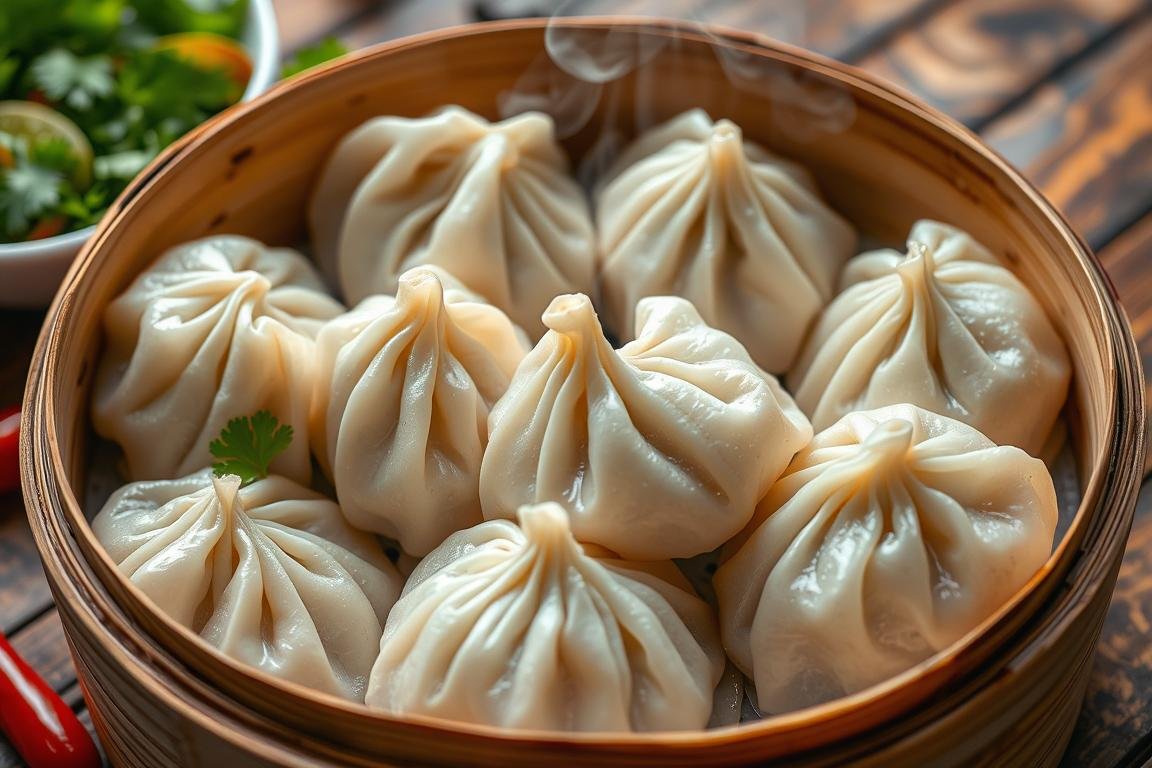
Did you know you can make your meals amazing with just water vapor? Steaming dumplings at home might seem hard, but don’t worry. With a few tips and some patience, you’ll learn an ancient Asian cooking skill. This guide will help you from picking the best stuff to making them steam right. You’ll get to enjoy homemade dumplings that taste wonderful.
Key Takeaways
- Steaming dumplings keeps their natural taste and feel and is healthy.
- Getting the dough’s flour-to-water mix right is key for great dumplings.
- For tasty and juicy fillings, it’s all about the lean-to-fat mix.
- Steamed dumplings cook fast, giving you a yummy meal in less than 20 minutes.
- Dipping sauces make dumplings even better with easy, delicious mixes.
- There’s an online course for those ready to explore Asian cooking techniques.
- Keep your steaming gear in good shape for great homemade dumplings.
Whether you’re experienced or new to cooking, steaming can make your meals special. Making the dough, wrapping, and steaming lets you add your own touch of love. Let’s simplify steaming so you can enjoy cozy, steamed dumplings at home.
What is Steaming?
Steaming is very important in Chinese cuisine. It uses steam’s gentle heat to cook, keeping foods’ natural tastes. Foods like dumplings keep their flavors and nutrients. This method doesn’t soak ingredients in water, so foods keep their good qualities.
Definition of Steaming
Steaming cooks food with boiling water’s steam. Ingredients are placed above the water. Then, steam cooks them softly and evenly. It’s great for delicate dishes like vegetables, seafood, and dumplings in Chinese cuisine.
History of Steaming as a Cooking Method
Steaming is key in Asian food history. It’s simple and effective, used for centuries. Generations have passed down steaming recipes. These range from veggies to complex dumplings. Steaming has improved over time to boost flavors and keep foods healthy.
Steaming is often chosen for dumplings. This method makes them firm but silky, unlike boiling which can make them burst or soggy. This shows why steaming is better for cooking dumplings.
| Method | Description | Texture | Cooking Time |
|---|---|---|---|
| Steaming | Uses vapor from boiling water | Firm yet silky | 10-15 minutes |
| Boiling | Submerges dumplings in water | Can burst, soggy | Varies |
| Steam-Frying | Fries then steams with water | Crispy bottom, tender top | Under 10 minutes |
Using these steaming methods, steaming dumplings is a favorite. It keeps the dumpling skins good and tastes whole. This is part of what makes Chinese cuisine special.
Benefits of Steaming
Steaming has lots of advantages. It’s great for making dishes that are good for you and taste great. It keeps the ingredients in top shape. This boosts their health benefits and taste.
Nutritional Advantages
Steaming is better than boiling or frying. It keeps the important vitamins and minerals in food. Vegetables and meats keep more vitamin C and folate. These are important for staying healthy. Steaming is great for healthy dumplings. They are yummy and good for you.
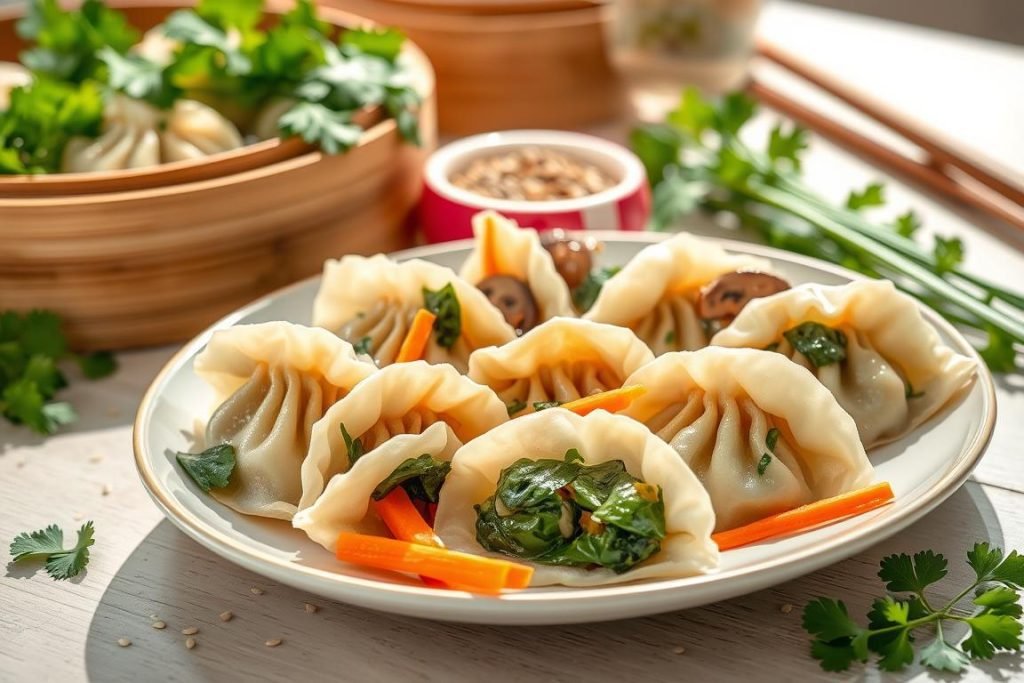
Steamed dumplings are very nutritious. They have only 67 calories but lots of protein. They are low in fat. This is good for those watching their weight. They don’t lose nutrients. This is something Asian cooking techniques do well.
Retaining Flavor and Color
Steaming keeps the real taste and bright colors of food. Veggies stay bright and crisp. This makes them look and taste better. Steam cooks food gently. This makes the dishes more flavorful without extra seasoning or oils. It’s great for fish and dumplings. Their natural flavors stand out.
Using veggies like cabbage as steam liners adds taste. It also prevents dumplings from sticking. This adds a veggie scent. It makes every bite even more enjoyable.
Steaming has many benefits. It’s great for those who care about health and flavor. It follows Asian cooking techniques. These focus on health and taste in food.
Tools Needed for Steaming
Steaming, like making steaming dumplings, needs special tools. These tools help you make the best of Chinese cuisine. Whether cooking at home or as a chef, knowing the right tools matters. It changes how your food tastes and feels.
Types of Steamers
Choosing the right steamer is key to good food. Bamboo steamers are great for many reasons. They last long and add a special scent to steaming dumplings. This makes eating them even better. You can find bamboo steamers in sizes like 8 to 10 inches. They’re good for meals big and small. You can also use stainless steel or electric steamers, but they might not smell as nice.
If you don’t want your dumplings to stick or tear, use silicone sheets. These sheets keep your dumplings looking good and whole while cooking.
Essential Equipment for Success
Besides the steamer, you need other tools too. A strong pot or wok is needed to hold water and the steamer safely. Use extra-long chopsticks to move delicate dumplings without breaking them. A spider strainer with a wooden handle is also useful for getting dumplings in and out of water.
If you want your dumplings perfect, a food scale is a must. Using it, chefs can make sure all dumplings are the same size. This helps them cook evenly every time.
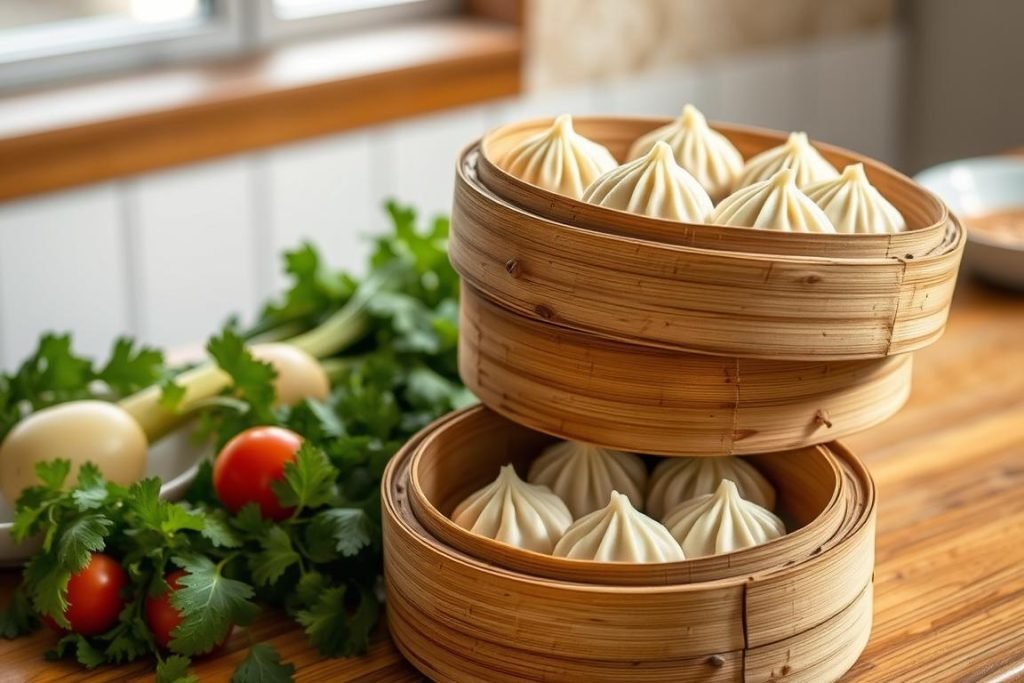
Having the right tools makes you better at making Chinese cuisine, like steaming dumplings. Whether choosing traditional bamboo or something new, each tool is important. They help make your food just right.
How to Prepare Ingredients for Steaming
Preparing your ingredients right is key to tasty steaming. Steaming is about careful choice and prep. Whether it’s veggies or dumplings, each step matters for yummy outcomes.
Choosing the Right Foods
It’s important to pick the right foods for steaming. Veggies, some meats, and dumplings work well. The best steamed dishes balance proteins and veggies. For dumplings, mix ground pork with a bit of fat. Add shrimp for more taste.
Prepping Fruits and Vegetables
Getting fruits and veggies ready helps a lot. Clean them, peel if needed, and cut evenly. For dumplings, chop ingredients like ginger finely. These steps make sure everything cooks well.
Using soy sauce, sesame oil, and Shaoxing wine makes fillings tasty. Keep wonton wrappers moist to avoid cracks.
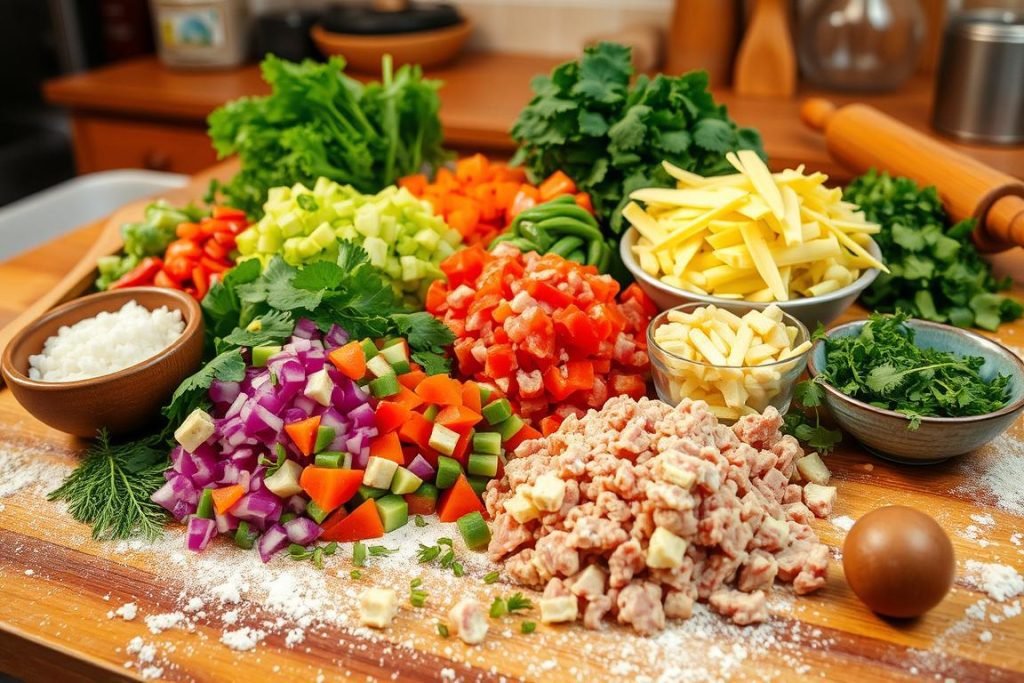
Keep wrappers covered to stop them drying out. For juicy dumplings, add veggies like carrots and mushrooms. Paying attention to these details helps make steaming successful.
| Ingredient | Preparation Note | Flavor Contribution |
|---|---|---|
| Ground Pork (70% meat, 30% fat) | Finely ground, mixed with seasoning | Provides a juicy, tender texture |
| Shrimp | Chopped coarsely | Adds a sweet, succulent flavor |
| Fresh Ginger | Minced | Offers a warm, earthy taste |
| Wonton Wrappers | Kept under a damp cloth to stay moist | Ensures elastic texture capable of holding fillings |
| Sesame Oil | Mixed into filling | Provides a hint of nutty aroma |
| Shaoxing Wine | Mixed into filling | Enhances overall depth of flavor |
Master these prep techniques for nutritious and flavorful steamed dishes. Good prep leads to great dishes!
Steaming Techniques
Learning how to steam food opens up a world of tastes, especially with favorites like Dim Sum and Wonton Wrappers. You can use a simple stove or an electric steamer. Knowing these Steaming Methods helps make your food just right.
Stovetop Steaming
To steam on a stove, you need a steamer basket and boiling water. This way works great for making amazing dim sum. Let’s look at how to set up your stove for steaming:
- Make sure the water doesn’t touch the steamer basket. This keeps food from getting wet and mushy.
- First, boil the water. Then, turn it down to simmer. This makes steady steam.
- Keep the steamer covered well. It cooks food evenly, which is important for Wonton Wrappers.
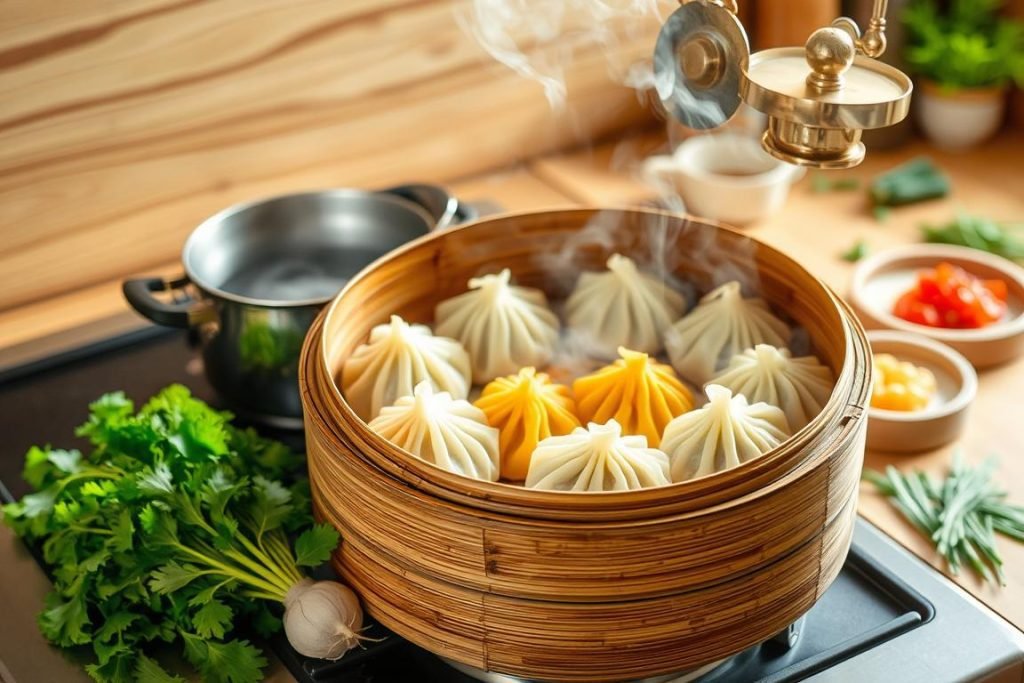
This method keeps the food’s taste and texture, especially for soft items like dim sum.
Electric Steaming
If you want easy and precise cooking, try an electric steamer. These gadgets have timers and shut off by themselves. So, your Dim Sum won’t get overcooked or too dry.
With an electric steamer, you don’t have to watch it all the time. Just fill it, set the time, and it cooks perfectly with little work.
Let’s look at the differences between these steaming ways:
| Feature | Stovetop Steaming | Electric Steaming |
|---|---|---|
| Equipment Needed | Bamboo basket or metal steamer | Electric steamer unit |
| Temperature Control | Manual control over heat source | Automated temperature settings |
| Usability | Monitoring required | Set-and-forget convenience |
| Suitability for Wonton Wrappers | High – gentle steam | High – even steam distribution |
| Initial Setup Cost | Lower, using common kitchen pots | Higher, specific appliance needed |
This table shows the differences and advantages of each method. Whether you use the old way or the new, you can make perfect Dim Sum. They will have the perfect feel and keep their flavor.
Popular Foods to Steam
Steaming food is great because it keeps the natural flavors and textures. This method works well for many dishes. People love steaming dumplings and dim sum. They show how diverse and efficient steaming can be.
Vegetables
Steamed vegetables keep their bright color and crispiness. This makes them look good and be good for you. Broccoli, carrots, and green beans are popular. They taste better and keep more nutrients when steamed.
Seafood
Seafood is great when steamed. It cooks gently, keeping the flavors and soft textures. Salmon, shrimp, and mussels are often steamed. This avoids the need for oil, making a lighter, healthier seafood dish.
Desserts
Steaming also works for desserts. It makes them soft and moist. Steamed puddings and rice cakes are good examples. They get a great texture and taste that is hard to get by baking or frying.

Dumplings are loved worldwide. They can have many different tastes and fillings. Dim sum includes tasty options like steamed pork dumplings. They’re juicy inside with a soft outside, thanks to steaming. Dumplings usually steam in about 10-15 minutes.
Using steam to cook is a smart choice. It makes your food options wider and healthier. Whether it’s the look of steamed veggies, the soft feel of seafood, or the smell of dim sum, steaming shows off the best in food.
Timing Your Steaming
Learning to steam dumplings right involves skill and precise timing. It matters for both big family meals and quick dinners. The right steaming time makes dumplings perfect in taste and texture, a key in Asian cooking techniques.
Knowing Cooking Times
Dumplings usually need 8-10 minutes to steam well. In a steam oven, fresh ones take about 12 minutes. Frozen ones need about 14 minutes because they’re colder. It’s good to change times based on dumpling size to cook them right.
Tips for Even Cooking
For even cooking, don’t put dumplings too close together. If they’re too close, they won’t steam well. This can mess up their taste and texture. Keep steam steady and check water often to stop the pot from going dry.
Use parchment paper in steam ovens to stop sticking. This helps them cook evenly too.
Good steaming dumplings comes from practice and timing. Use these tips for delicious dumplings your guests will love. Their taste and look will surely impress.
Flavoring Steamed Foods
To make steamed dishes taste better, we add seasoning and dipping sauces. Steaming keeps the food’s natural taste. But, adding tasty fillings and sauces makes it even better.
Using Herbs and Spices
Adding herbs and spices to dumplings makes them flavorful. For example, mix green scallions and grated ginger into pork. This makes the dumplings very tasty, even without sauce.
Adding Sauces
After steaming, sauces make the dish taste great. A simple sauce with soy sauce, rice vinegar, and sesame oil works well. Adding red pepper flakes can make it spicy. These mixes improve the taste of dumplings and other dishes.
Let’s look at how cooking methods change dumplings. We’ll see how fillings and sauces help with taste:
| Cooking Method | Texture | Pressure on Dumplings | Suitability for Fillings |
|---|---|---|---|
| Steaming | Plump, intact | Low | Excellent for thin and delicate skins |
| Boiling | Can disintegrate | High | Not suitable for thin-skinned dumplings |
| Steam-frying | Bottom crisp, top tender | Moderate | Good for an added texture contrast |
Steaming is best for keeping dumpling skins perfect. It works well with tasty fillings and light sauces. This method is a favorite in Chinese cooking. It keeps flavors and textures just right.
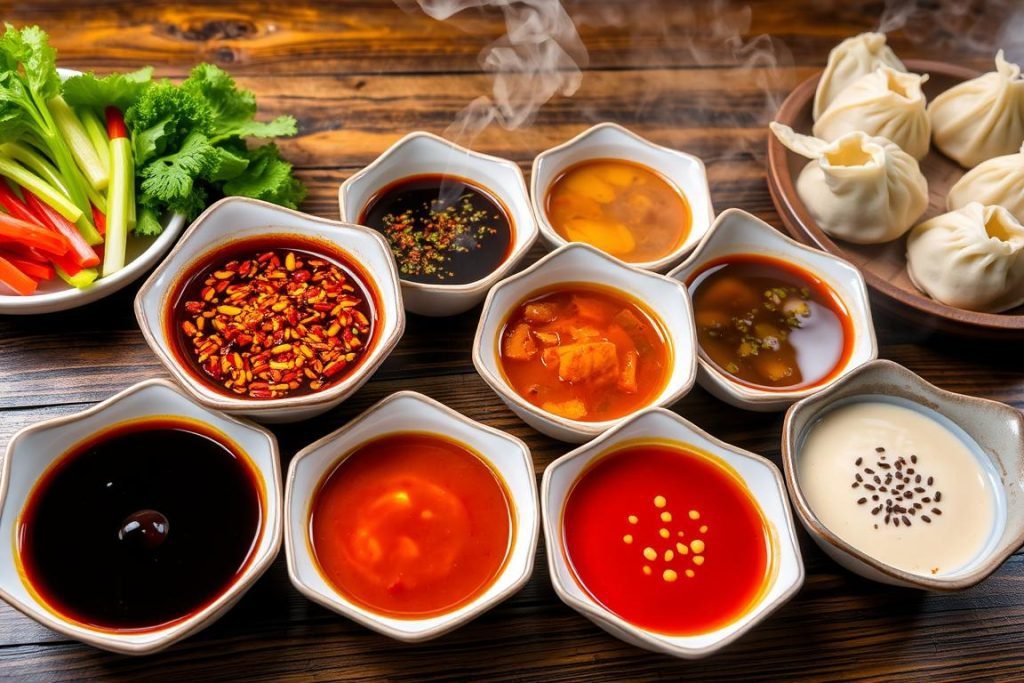
Common Mistakes to Avoid
When starting with steaming methods and cooking techniques, avoid certain mistakes for success. We will focus on two big errors made by beginners, especially with dumplings.
Overcrowding the Steamer
Putting too many dumplings in the steamer is a big mistake. It can block steam flow, leading to uneven cooking. Make sure there’s enough room for steam to reach each dumpling. This helps them cook well and look great.
Ignoring Cooking Times
Not following cooking times is another mistake. It can cause under or overcooking. Always stick to the recommended times. Use a toothpick to see if dumplings need more time, depending on their size and filling.
| Dumpling Type | Recommended Steaming Time | Wrapper Thickness | Common Mistakes |
|---|---|---|---|
| Basic pork & vegetable | 10 minutes | Medium | Using overly wet filling |
| Chicken & mushroom | 12 minutes | Thin | Over-stuffing |
| Shrimp & chives | 8 minutes | Thin | Sealing improperly |
Learning steaming ways means knowing what not to do too. Avoiding these mistakes ensures your dumplings will be yummy!
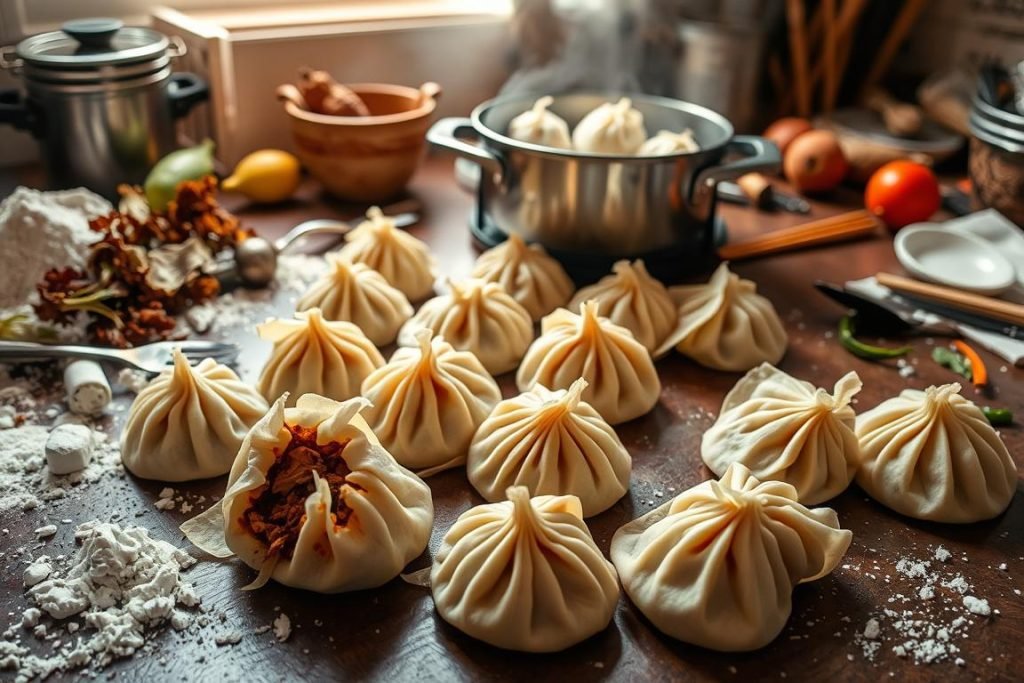
Cleaning and Maintaining Your Steamer
It’s key to take care of your steaming tools well. This makes sure your food stays tasty. It also helps your steamer last a long time. Here are tips to keep your steamers, like bamboo ones, working well.
Regular Maintenance Tips
First, clean your bamboo steamer every time you use it. This stops buildup and keeps it clean. Since you can’t put it in the dishwasher, wash it by hand instead. Use a soft brush to gently clean the bamboo. Then, use a dish towel to pat it dry.
Make sure the steamer is totally dry before putting it away. Don’t stack the pieces until they’ve air-dried. This avoids mold and the bamboo warping. That way, it’s ready to use next time.
Cleaning Different Types of Steamers
Bamboo steamers need special care. Here are some special cleaning tips:
- Using a lemon helps clean and make it smell nice. Rub a lemon slice on the steamer.
- Treating it with a tea bag in hot water also works. It cuts through grease and kills germs.
Metal and other steamers just need soap and warm water. Be sure to dry them right away. This stops them from rusting, especially the metal ones.
When using a bamboo steamer, watch the water while cooking. This stops burns on the vessel and bamboo. The bottom layers get hotter and need more attention.
Using these cleaning techniques keeps your bamboo steamers ready. They’ll be set for your next healthy meal.
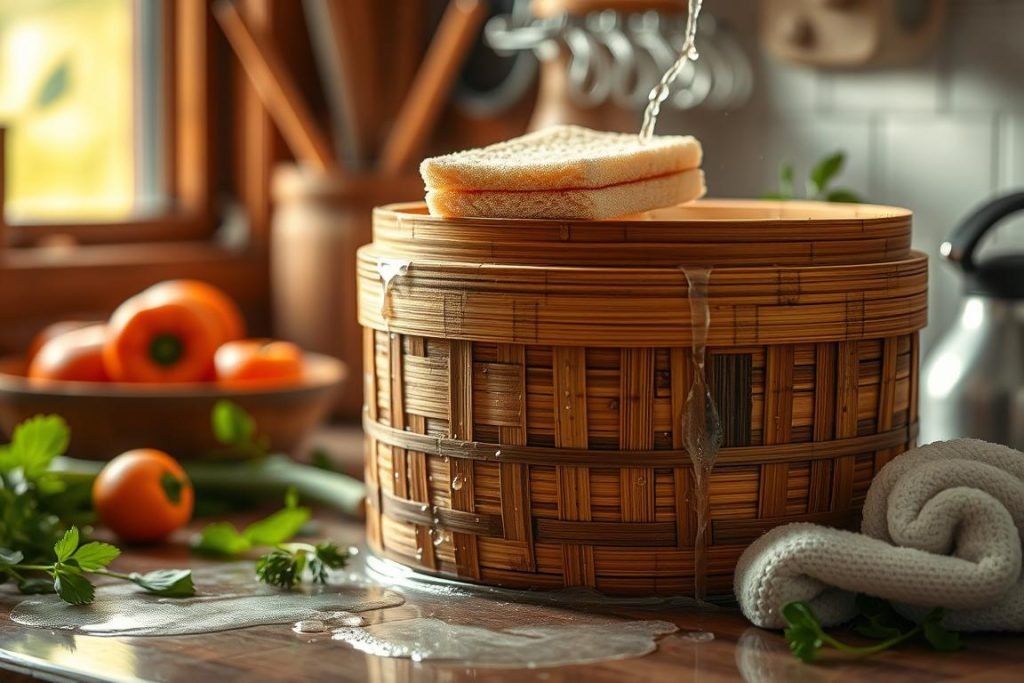
Steaming Recipes to Try
Expand your cooking skills with simple Asian techniques. Try these steaming recipes. Enjoy a light veggie side or a rich seafood main. These dishes use steaming to keep flavors and nutrition strong.
Simple Veggie Medley
Try this easy dish full of colorful veggies like broccoli, carrots, and bok choy. Steaming keeps their nutrients and colors bright. It’s great as a tasty side or a light main dish.
Just a short steam keeps all the good taste. Try it and see!
Perfectly Steamed Fish
Want a taste of the sea? Try steamed fish with ginger and soy sauce. Use a bamboo steamer for this special dish. It cooks the fish gently, making it moist and flaky.
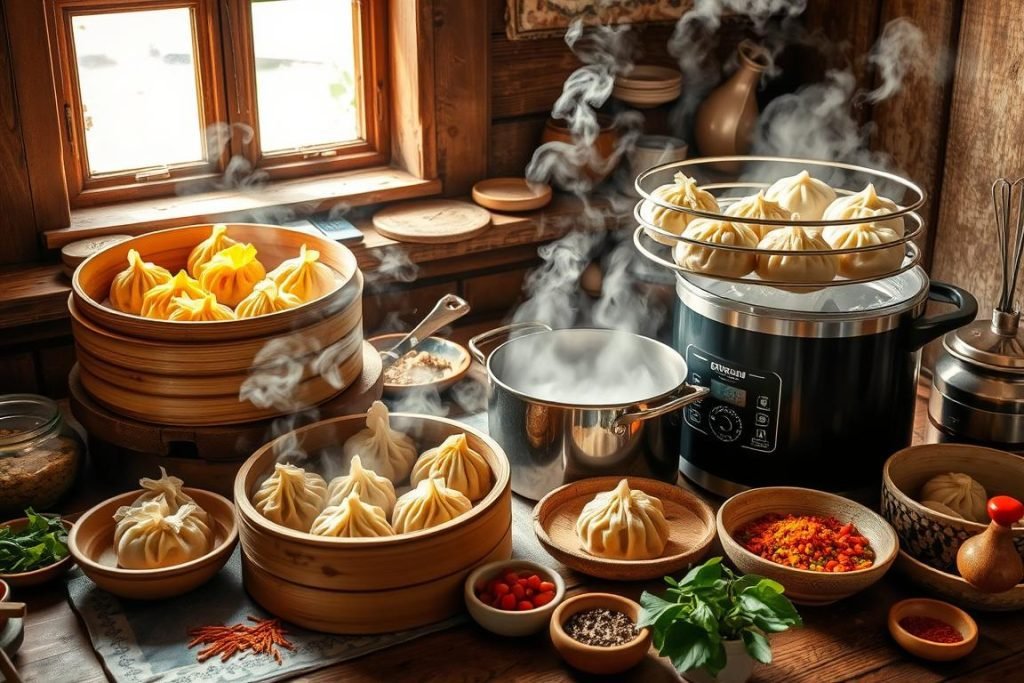
| Ingredient | Quantity | Instructions |
|---|---|---|
| Ground Pork | ¾ pound | Mix well with other ingredients |
| Minced Green Onions, Ginger, Garlic | 2 tbsp, 1 tsp, 1 clove | Combine with pork |
| Shitake Mushrooms, Bamboo Shoots | 4, 3 tbsp | Finely chop and mix |
| Chinese Rice Wine, Soy Sauce, Cornstarch | 1 tbsp, 1 ½ tbsp, 2 tbsp | Add for flavoring and binding |
| Cabbage Leaves for Lining | 5 large leaves | Line steamer |
| Wonton Skins | 40 pieces | Wrap filling |
| Steaming Time | 20 minutes | Cook until done |
This table shows what you need for Chinese steamed dumplings. With these steaming methods, you will get better at Asian cooking. Each meal lets you explore more dumpling recipes.
Conclusion and Encouragement
Wrapping up, you learned steaming dumplings is an art. It comes from rich Asian cooking traditions. Steaming keeps the food’s goodness and offers lots of nutritional benefits. It can’t be compared to other cooking ways. You now know the tools needed to be great at this cooking skill.
Recap of Key Points
Remember, great homemade dumplings start with the best ingredients and getting the dough just right. Let the dough rest for 30 minutes. Choose fillings you like, such as ground pork or tofu. Learning to fold wrappers is important. It makes the dumplings look and taste better. Steam them for 15-20 minutes and enjoy them with soy sauce and rice vinegar.
Start Your Steaming Journey!
Your adventure in Asian cooking begins now. The Han dynasty showed us the importance of sharing recipes. Use your skills to join in on culinary talks. This ties into learning and celebrating history. It doesn’t matter if you’re in school or at home. It’s time to make fantastic dumplings yourself.
Leave store-bought wrappers. Make your dough. Watch as simple veggies turn into yummy dumplings. With your bamboo steamer and excitement, get ready for a tasty and joyful journey.